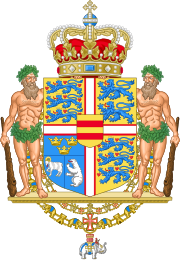1953 Danish Landsting election
 |
|---|
Landsting elections were held in Denmark in April 1953 alongside elections to the Folketing. They were the last elections to the upper house of the Rigsdagen, as the Landsting was abolished later in the year following the introduction of a new constitution approved in a June referendum, with the Folketing (previously the lower house) becoming a unicameral parliament.
Background
[edit]Although the new constitution had been approved by the Rigsdagen, the previous constitution constitution required elections to be called for a new Rigsdagen which would approve the new constitution again before it could be signed by the monarch and come into force.
Electoral system
[edit]The elections took place in two rounds, with the public electing 4,335 members of an electoral college on 21 April,[1] who in turn elected the members of the Landsting on 28 April.
Results
[edit] | |||||||||
|---|---|---|---|---|---|---|---|---|---|
| Party | Votes | % | Electors | Seats | |||||
| People's | Parliament | Total | +/– | ||||||
| Social Democratic Party | 639,656 | 40.08 | 1,789 | 24 | 9 | 33 | 0 | ||
| Venstre | 366,268 | 22.95 | 1,093 | 16 | 3 | 22 | 0 | ||
| Conservative People's Party | 286,638 | 17.96 | 767 | 10 | 3 | 13 | +1 | ||
| Danish Social Liberal Party | 141,121 | 8.84 | 349 | 5 | 1 | 6 | 0 | ||
| Justice Party of Denmark | 79,036 | 4.95 | 175 | 1 | 0 | 1 | 0 | ||
| Communist Party of Denmark | 69,928 | 4.38 | 141 | 0 | 0 | 0 | –1 | ||
| Schleswig Party | 7,447 | 0.47 | 21 | 0 | 0 | 0 | New | ||
| Danish Unity | 5,944 | 0.37 | 0 | 0 | 0 | 0 | 0 | ||
| Faroese representative | – | 0 | 0 | 1 | 0 | ||||
| Total | 1,596,038 | 100.00 | 4,335 | 56 | 16 | 76 | 0 | ||
| Source: Statistiske efterretninger (votes)[2] | |||||||||
Aftermath
[edit]The constitution was adopted unchanged by the both houses of parliament and then approved by the public in a referendum on 28 May. It was signed by King Frederik IX on 5 June and entered into force immediately. The Landsting continued to existed until the general elections to the newly unicameral Folketing on 22 September 1953.
References
[edit]- ^ Dieter Nohlen & Philip Stöver (2010) Elections in Europe: A data handbook, p. 524 ISBN 978-3-8329-5609-7
- ^ Statistiske efterretninger. Vol. 45. 1953. p. 264.
